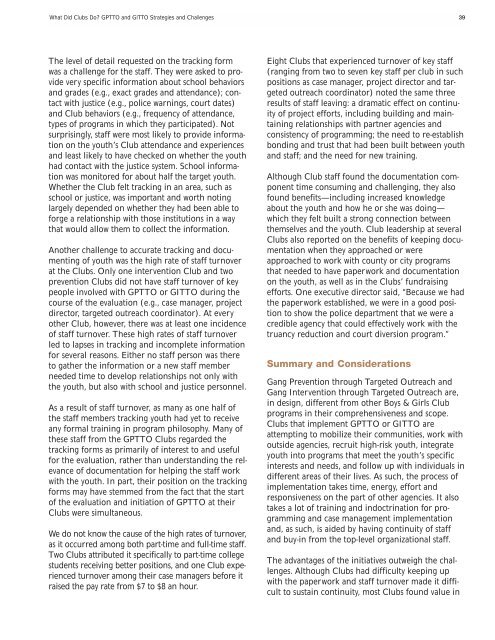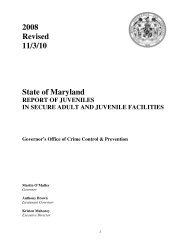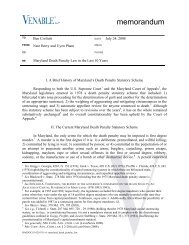Targeted Outreach - Governor's Office of Crime Control & Prevention ...
Targeted Outreach - Governor's Office of Crime Control & Prevention ...
Targeted Outreach - Governor's Office of Crime Control & Prevention ...
You also want an ePaper? Increase the reach of your titles
YUMPU automatically turns print PDFs into web optimized ePapers that Google loves.
What Did Clubs Do? GPTTO and GITTO Strategies and Challenges 39<br />
The level <strong>of</strong> detail requested on the tracking form<br />
was a challenge for the staff. They were asked to provide<br />
very specific information about school behaviors<br />
and grades (e.g., exact grades and attendance); contact<br />
with justice (e.g., police warnings, court dates)<br />
and Club behaviors (e.g., frequency <strong>of</strong> attendance,<br />
types <strong>of</strong> programs in which they participated). Not<br />
surprisingly, staff were most likely to provide information<br />
on the youth’s Club attendance and experiences<br />
and least likely to have checked on whether the youth<br />
had contact with the justice system. School information<br />
was monitored for about half the target youth.<br />
Whether the Club felt tracking in an area, such as<br />
school or justice, was important and worth noting<br />
largely depended on whether they had been able to<br />
forge a relationship with those institutions in a way<br />
that would allow them to collect the information.<br />
Another challenge to accurate tracking and documenting<br />
<strong>of</strong> youth was the high rate <strong>of</strong> staff turnover<br />
at the Clubs. Only one intervention Club and two<br />
prevention Clubs did not have staff turnover <strong>of</strong> key<br />
people involved with GPTTO or GITTO during the<br />
course <strong>of</strong> the evaluation (e.g., case manager, project<br />
director, targeted outreach coordinator). At every<br />
other Club, however, there was at least one incidence<br />
<strong>of</strong> staff turnover. These high rates <strong>of</strong> staff turnover<br />
led to lapses in tracking and incomplete information<br />
for several reasons. Either no staff person was there<br />
to gather the information or a new staff member<br />
needed time to develop relationships not only with<br />
the youth, but also with school and justice personnel.<br />
As a result <strong>of</strong> staff turnover, as many as one half <strong>of</strong><br />
the staff members tracking youth had yet to receive<br />
any formal training in program philosophy. Many <strong>of</strong><br />
these staff from the GPTTO Clubs regarded the<br />
tracking forms as primarily <strong>of</strong> interest to and useful<br />
for the evaluation, rather than understanding the relevance<br />
<strong>of</strong> documentation for helping the staff work<br />
with the youth. In part, their position on the tracking<br />
forms may have stemmed from the fact that the start<br />
<strong>of</strong> the evaluation and initiation <strong>of</strong> GPTTO at their<br />
Clubs were simultaneous.<br />
We do not know the cause <strong>of</strong> the high rates <strong>of</strong> turnover,<br />
as it occurred among both part-time and full-time staff.<br />
Two Clubs attributed it specifically to part-time college<br />
students receiving better positions, and one Club experienced<br />
turnover among their case managers before it<br />
raised the pay rate from $7 to $8 an hour.<br />
Eight Clubs that experienced turnover <strong>of</strong> key staff<br />
(ranging from two to seven key staff per club in such<br />
positions as case manager, project director and targeted<br />
outreach coordinator) noted the same three<br />
results <strong>of</strong> staff leaving: a dramatic effect on continuity<br />
<strong>of</strong> project efforts, including building and maintaining<br />
relationships with partner agencies and<br />
consistency <strong>of</strong> programming; the need to re-establish<br />
bonding and trust that had been built between youth<br />
and staff; and the need for new training.<br />
Although Club staff found the documentation component<br />
time consuming and challenging, they also<br />
found benefits—including increased knowledge<br />
about the youth and how he or she was doing—<br />
which they felt built a strong connection between<br />
themselves and the youth. Club leadership at several<br />
Clubs also reported on the benefits <strong>of</strong> keeping documentation<br />
when they approached or were<br />
approached to work with county or city programs<br />
that needed to have paperwork and documentation<br />
on the youth, as well as in the Clubs’ fundraising<br />
efforts. One executive director said, “Because we had<br />
the paperwork established, we were in a good position<br />
to show the police department that we were a<br />
credible agency that could effectively work with the<br />
truancy reduction and court diversion program.”<br />
Summary and Considerations<br />
Gang <strong>Prevention</strong> through <strong>Targeted</strong> <strong>Outreach</strong> and<br />
Gang Intervention through <strong>Targeted</strong> <strong>Outreach</strong> are,<br />
in design, different from other Boys & Girls Club<br />
programs in their comprehensiveness and scope.<br />
Clubs that implement GPTTO or GITTO are<br />
attempting to mobilize their communities, work with<br />
outside agencies, recruit high-risk youth, integrate<br />
youth into programs that meet the youth’s specific<br />
interests and needs, and follow up with individuals in<br />
different areas <strong>of</strong> their lives. As such, the process <strong>of</strong><br />
implementation takes time, energy, effort and<br />
responsiveness on the part <strong>of</strong> other agencies. It also<br />
takes a lot <strong>of</strong> training and indoctrination for programming<br />
and case management implementation<br />
and, as such, is aided by having continuity <strong>of</strong> staff<br />
and buy-in from the top-level organizational staff.<br />
The advantages <strong>of</strong> the initiatives outweigh the challenges.<br />
Although Clubs had difficulty keeping up<br />
with the paperwork and staff turnover made it difficult<br />
to sustain continuity, most Clubs found value in

















